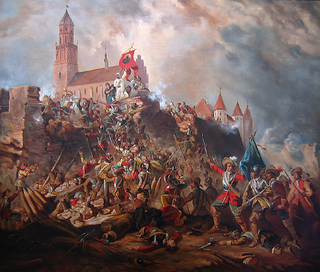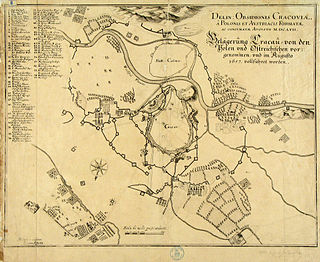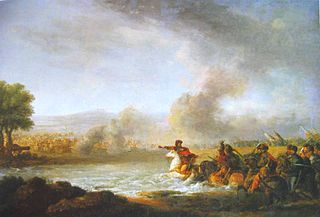 W
WThe Siege of Jasna Góra took place in the winter of 1655 during the Second Northern War, or 'The Deluge' — as the Swedish invasion of the Polish–Lithuanian Commonwealth is known. The Swedes were attempting to capture the Jasna Góra monastery in Częstochowa. Their month-long siege, however, was unsuccessful, as a small force consisting of monks from the Jasna Góra monastery led by their Prior and supported by local volunteers, mostly from the szlachta, fought off the numerically superior Germans, saved their sacred icon, the Black Madonna of Częstochowa and, according to some accounts, turned the course of the war.
 W
WThe Battle of Filipów was fought on October 22, 1656 between forces of the Polish–Lithuanian Commonwealth commanded by Field Lithuanian Hetman Wincenty Korwin Gosiewski on one side, and on the other allied Swedish and Brandenburg-Prussia forces commanded by Gustaf Otto Stenbock and Prince Georg Friedrich of Waldeck. The battle ended with victory for the Swedish-Brandenburg-Prussian troops.
 W
WThe Battle of Gołąb was fought on either February 18 or 19, 1656 between forces of the Polish–Lithuanian Commonwealth commanded by Stefan Czarniecki on one side, and on the other Swedish Empire's army commanded by Charles X Gustav. This battle was essentially a meeting engagement with Swedish troops arriving on the battlefield at different times. It is uncertain how many actually participated, and its actual date is disputed. Some sources, such as Polish-language Military Encyclopedia, claim it took place on February 18, while historian Leszek Podhorecki wrote that it was on February 19. The result was a Swedish victory.
 W
WThe Battle of Kłecko was fought on May 7, 1656, between forces of the Polish–Lithuanian Commonwealth commanded by Regimentarz Stefan Czarniecki and Jerzy Sebastian Lubomirski and a Swedish force commanded by prince Adolf Johan av Pfalz-Zweibrücken. The Polish–Lithuanian force was more than 12,000 strong and consisted mostly of cavalry, while the Swedes numbered around 7,000 artillery, infantry and cavalry. The Swedes achieved a tactical victory in that they escaped destruction by the Poles, who were unable to get to the Swedish army entrenched behind the Welnianka River, and various ditches and swamps. Swedish army lost 428 dead, while the Polish army sustained 70 dead and wounded, 2,000 dead or 3,000 dead, including 40 companions dead.
 W
WThe Siege of Kolding was fought on December 25, 1658, between Sweden and the forces of the Polish–Lithuanian Commonwealth and Denmark–Norway. The Polish and Danish forces were led by Stefan Czarniecki. The Polish-Danish force won the battle.
 W
WThe siege of Kraków was one of the battles during the Swedish invasion of Polish–Lithuanian Commonwealth. It started on 25 September 1655 and ended on 13 October 1655. Capitulation treatment was signed 4 days later. Polish troops marched out the city on 19 October. The city's defense was led by Kiev's castellan Stefan Czarniecki, while Swedish forces were commanded by king Charles Gustav and Arvid Wittenberg.
 W
WThe Siege of Kraków was one of the military conflicts of the Swedish and Transylvanian invasion of Poland, which took place in the summer of 1657. The royal city of Kraków, had been occupied for two years by a Swedish-Transylvanian garrison led by Paul Wirtz and János Bethlen. It was besieged by Polish Army of Hetman Jerzy Lubomirski, supported by soldiers of the Holy Roman Empire under Austrian Field Marshal Melchior von Hatzfeldt.
 W
WThe Battle of Nowy Dwór was fought during September 20 – September 30, 1655 between forces of the Polish–Lithuanian Commonwealth commanded by Jan Kazimierz Krasiński on one side, and on the other Swedish Empire forces commanded by Gustaf Otto Stenbock. It ended in Swedish victory.
 W
WThe Battle of Nyborg was a battle fought between Sweden and the combined forces of Denmark, Dutch naval forces under Michiel de Ruyter, troops of Brandenburg-Prussia, and Polish–Lithuanian Commonwealth forces under Stefan Czarniecki. The battle was engaged on 14 November 1659 at Nyborg on the Danish island of Funen. Nyborg was the final major conflict of the Dano-Swedish War of 1658 to 1660.
 W
WThe Battle of Chojnice was a surprise nighttime attack followed by a run-and-chase battle during The Deluge.
 W
WThe Battle of Warka on April 7, 1656 between forces of the Polish–Lithuanian Commonwealth commanded by Stefan Czarniecki on one side, and on the other Swedish forces commanded by Frederick VI, Margrave of Baden-Durlach. Battle was fought for about two hours, ending in Polish victory. It was the first Polish success in the open field since Swedish invasion of Poland in early summer 1655.
 W
WDuring the Swedish Deluge on May 18, 1658, the Hussar Captain Samuel Komorowski fought the unresolved battle against the army of Field Marshal Robert Douglas, who was forced to resign from the attack on Żmudź.
 W
WThe Battle of Ujście was fought on July 24–25, 1655 between forces of the Polish–Lithuanian Commonwealth commanded by Krzysztof Opaliński and Andrzej Grudziński on one side, and on the other Swedish forces commanded by Arvid Wittenberg. Krzysztof Opaliński and Bogusław Leszczyński, dissatisfied with policies of King John II Casimir of Poland, decided to become Swedish allies together with the pospolite ruszenie of Greater Poland to Charles X Gustav of Sweden.
 W
WThe Battle of Warsaw was a battle which took place near Warsaw on July 28–July 30 [O.S. July 18–20] 1656, between the armies of the Polish–Lithuanian Commonwealth and Sweden and Brandenburg. It was a major battle in the Second Northern War between Poland and Sweden in the period 1655–1660, also known as The Deluge. According to Hajo Holborn, it marked "the beginning of Prussian military history".
 W
WThe Siege of Warsaw took place between April 24 and July 1, 1656. Swedish Empire forces had occupied the Polish capital without fighting in early September 1655. In late April 1656, Poles and Lithuanians began the siege, with the purpose of recapturing their capital. They were successful, but later lost the city for a second time after a battle held on July 28–30, 1656.
 W
WThe Battle of Wojnicz was fought around the medieval town of Wojnicz in Lesser Poland as part of the Second Northern War on October 3, 1655 between forces of the Polish–Lithuanian Commonwealth commanded by Field Crown Hetman Stanisław Lanckoroński and Great Crown Hetman Stanisław Rewera Potocki on one side, and on the other, the invading Swedish forces commanded by King Charles X Gustav. The battle ended in a Swedish victory.
 W
WSiege of Zamość was part of The Deluge, a series of campaigns in the Polish–Lithuanian Commonwealth, that took place in early 1656.
 W
WThe Battle of Żarnów was fought on September 16, 1655, between the forces of the Polish–Lithuanian Commonwealth, commanded by John II Casimir and the forces of the Swedish Empire, commanded by Charles X Gustav. The result ended with a Swedish victory.